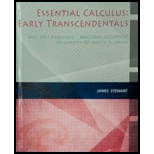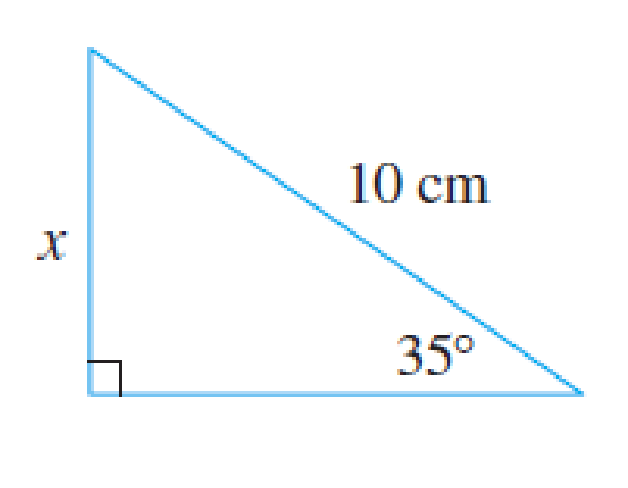
Essential Calculus: Early Transcendentals; MAC 2311 Sequence| MAC 2281Sequence USF (Essential Calculus)
2nd Edition
ISBN: 9781285101552
Author: James Stewart
Publisher: Cenage
expand_more
expand_more
format_list_bulleted
Concept explainers
Textbook Question
Chapter A, Problem 35E
Find, correct to five decimal places, the length of the side labeled x.

Expert Solution & Answer
Want to see the full answer?
Check out a sample textbook solution
Students have asked these similar questions
(7) (12 points) Let F(x, y, z) = (y, x+z cos yz, y cos yz).
Ꮖ
(a) (4 points) Show that V x F = 0.
(b) (4 points) Find a potential f for the vector field F.
(c) (4 points) Let S be a surface in R3 for which the Stokes' Theorem is valid. Use
Stokes' Theorem to calculate the line integral
Jos
F.ds;
as denotes the boundary of S. Explain your answer.
(3) (16 points) Consider
z = uv,
u = x+y,
v=x-y.
(a) (4 points) Express z in the form z = fog where g: R² R² and f: R² →
R.
(b) (4 points) Use the chain rule to calculate Vz = (2, 2). Show all intermediate
steps otherwise no credit.
(c) (4 points) Let S be the surface parametrized by
T(x, y) = (x, y, ƒ (g(x, y))
(x, y) = R².
Give a parametric description of the tangent plane to S at the point p = T(x, y).
(d) (4 points) Calculate the second Taylor polynomial Q(x, y) (i.e. the quadratic
approximation) of F = (fog) at a point (a, b). Verify that
Q(x,y) F(a+x,b+y).
=
(6) (8 points) Change the order of integration and evaluate
(z +4ry)drdy .
So S√ ²
0
Chapter A Solutions
Essential Calculus: Early Transcendentals; MAC 2311 Sequence| MAC 2281Sequence USF (Essential Calculus)
Ch. A - Prob. 1ECh. A - Convert from degrees to radians. 300Ch. A - Convert from degrees to radians. 9Ch. A - Convert from degrees to radians. 315Ch. A - Convert from degrees to radians. 900Ch. A - Convert from degrees to radians. 36Ch. A - Convert from radians to degrees. 4Ch. A - Convert from radians to degrees. 72Ch. A - Convert from radians to degrees. 512Ch. A - Convert from radians to degrees. 83
Ch. A - Convert from radians to degrees. 38Ch. A - Convert from radians to degrees. 5Ch. A - Find the length of a circular arc subtended by an...Ch. A - If a circle has radius 10 cm, find the length of...Ch. A - A circle has radius 1.5 m. What angle is subtended...Ch. A - Find the radius of a circular sector with angle...Ch. A - Draw, in standard position, the angle whose...Ch. A - Draw, in standard position, the angle whose...Ch. A - Draw, in standard position, the angle whose...Ch. A - Draw, in standard position, the angle whose...Ch. A - Draw, in standard position, the angle whose...Ch. A - Draw, in standard position, the angle whose...Ch. A - Find the exact trigonometric ratios for the angle...Ch. A - Find the exact trigonometric ratios for the angle...Ch. A - Find the exact trigonometric ratios for the angle...Ch. A - Find the exact trigonometric ratios for the angle...Ch. A - Find the exact trigonometric ratios for the angle...Ch. A - Find the exact trigonometric ratios for the angle...Ch. A - Find the remaining trigonometric ratios. sin=35,02Ch. A - Find the remaining trigonometric ratios. tan=2,02Ch. A - Find the remaining trigonometric ratios. sec=1.5,2Ch. A - Find the remaining trigonometric ratios....Ch. A - Find the remaining trigonometric ratios. cot=3,2Ch. A - Find the remaining trigonometric ratios....Ch. A - Find, correct to five decimal places, the length...Ch. A - Find, correct to five decimal places, the length...Ch. A - Find, correct to five decimal places, the length...Ch. A - Find, correct to five decimal places, the length...Ch. A - Prove each equation. (a) Equation 10a (b) Equation...Ch. A - Prove each equation. (a) Equation 14a (b) Equation...Ch. A - Prove each equation. (a) Equation 18a (b) Equation...Ch. A - Prove the identity. cos(2x)=sinxCh. A - Prove the identity. sin(2+x)=cosxCh. A - Prove the identity. sin(x)=sinxCh. A - Prove the identity. sincot=cosCh. A - Prove the identity. (sinx+cosx)2=1+sin2xCh. A - Prove the identity. secycosy=tanysinyCh. A - Prove the identity. tan2sin2=tan2sin2Ch. A - Prove the identity. cot2+sec2=tan2+csc2Ch. A - Prove the identity. 2csc2t=sectcsctCh. A - Prob. 51ECh. A - Prob. 52ECh. A - Prob. 53ECh. A - Prob. 54ECh. A - Prob. 55ECh. A - Prob. 56ECh. A - Prob. 57ECh. A - Prob. 58ECh. A - Prob. 59ECh. A - Prob. 60ECh. A - Prob. 61ECh. A - Prob. 62ECh. A - Prob. 63ECh. A - Prob. 64ECh. A - Prob. 65ECh. A - Prob. 66ECh. A - Prob. 67ECh. A - Prob. 68ECh. A - Prob. 69ECh. A - Prob. 70ECh. A - Prob. 71ECh. A - Prob. 72ECh. A - Prob. 73ECh. A - Prob. 74ECh. A - Prob. 75ECh. A - Prob. 76ECh. A - Prob. 77ECh. A - Prob. 78ECh. A - Prob. 79ECh. A - Prob. 80ECh. A - Prob. 81ECh. A - Prob. 82ECh. A - Prob. 83ECh. A - Prob. 84ECh. A - Prob. 85ECh. A - Prob. 86ECh. A - Prob. 87ECh. A - Prob. 88ECh. A - Find the area of triangle ABC, correct to five...
Knowledge Booster
Learn more about
Need a deep-dive on the concept behind this application? Look no further. Learn more about this topic, calculus and related others by exploring similar questions and additional content below.Similar questions
- (10) (16 points) Let R>0. Consider the truncated sphere S given as x² + y² + (z = √15R)² = R², z ≥0. where F(x, y, z) = −yi + xj . (a) (8 points) Consider the vector field V (x, y, z) = (▼ × F)(x, y, z) Think of S as a hot-air balloon where the vector field V is the velocity vector field measuring the hot gasses escaping through the porous surface S. The flux of V across S gives the volume flow rate of the gasses through S. Calculate this flux. Hint: Parametrize the boundary OS. Then use Stokes' Theorem. (b) (8 points) Calculate the surface area of the balloon. To calculate the surface area, do the following: Translate the balloon surface S by the vector (-15)k. The translated surface, call it S+ is part of the sphere x² + y²+z² = R². Why do S and S+ have the same area? ⚫ Calculate the area of S+. What is the natural spherical parametrization of S+?arrow_forward(1) (8 points) Let c(t) = (et, et sint, et cost). Reparametrize c as a unit speed curve starting from the point (1,0,1).arrow_forward(9) (16 points) Let F(x, y, z) = (x² + y − 4)i + 3xyj + (2x2 +z²)k = - = (x²+y4,3xy, 2x2 + 2²). (a) (4 points) Calculate the divergence and curl of F. (b) (6 points) Find the flux of V x F across the surface S given by x² + y²+2² = 16, z ≥ 0. (c) (6 points) Find the flux of F across the boundary of the unit cube E = [0,1] × [0,1] x [0,1].arrow_forward
- (8) (12 points) (a) (8 points) Let C be the circle x² + y² = 4. Let F(x, y) = (2y + e²)i + (x + sin(y²))j. Evaluate the line integral JF. F.ds. Hint: First calculate V x F. (b) (4 points) Let S be the surface r² + y² + z² = 4, z ≤0. Calculate the flux integral √(V × F) F).dS. Justify your answer.arrow_forwardDetermine whether the Law of Sines or the Law of Cosines can be used to find another measure of the triangle. a = 13, b = 15, C = 68° Law of Sines Law of Cosines Then solve the triangle. (Round your answers to four decimal places.) C = 15.7449 A = 49.9288 B = 62.0712 × Need Help? Read It Watch Itarrow_forward(4) (10 points) Evaluate √(x² + y² + z²)¹⁄² exp[}(x² + y² + z²)²] dV where D is the region defined by 1< x² + y²+ z² ≤4 and √√3(x² + y²) ≤ z. Note: exp(x² + y²+ 2²)²] means el (x²+ y²+=²)²]¸arrow_forward
- (2) (12 points) Let f(x,y) = x²e¯. (a) (4 points) Calculate Vf. (b) (4 points) Given x directional derivative 0, find the line of vectors u = D₁f(x, y) = 0. (u1, 2) such that the - (c) (4 points) Let u= (1+3√3). Show that Duƒ(1, 0) = ¦|▼ƒ(1,0)| . What is the angle between Vf(1,0) and the vector u? Explain.arrow_forwardFind the missing values by solving the parallelogram shown in the figure. (The lengths of the diagonals are given by c and d. Round your answers to two decimal places.) a b 29 39 66.50 C 17.40 d 0 54.0 126° a Ꮎ b darrow_forward(5) (10 points) Let D be the parallelogram in the xy-plane with vertices (0, 0), (1, 1), (1, 1), (0, -2). Let f(x,y) = xy/2. Use the linear change of variables T(u, v)=(u,u2v) = (x, y) 1 to calculate the integral f(x,y) dA= 0 ↓ The domain of T is a rectangle R. What is R? |ǝ(x, y) du dv. |ð(u, v)|arrow_forward
- 2 Anot ined sove in peaper PV+96252 Q3// Find the volume of the region between the cylinder z = y2 and the xy- plane that is bounded by the planes x=1, x=2,y=-2,andy=2. vertical rect a Q4// Draw and Evaluate Soxy-2sin (ny2)dydx D Lake tarrow_forwardDetermine whether the Law of Sines or the Law of Cosines can be used to find another measure of the triangle. B 13 cm 97° Law of Sines Law of Cosines A 43° Then solve the triangle. (Round your answers to two decimal places.) b = x C = A = 40.00arrow_forwardFind the missing values by solving the parallelogram shown in the figure. (The lengths of the diagonals are given by c and d. Round your answers to two decimal places.) a 29 b 39 d Ꮎ 126° a Ꮎ b darrow_forward
arrow_back_ios
SEE MORE QUESTIONS
arrow_forward_ios
Recommended textbooks for you
 Mathematics For Machine TechnologyAdvanced MathISBN:9781337798310Author:Peterson, John.Publisher:Cengage Learning,
Mathematics For Machine TechnologyAdvanced MathISBN:9781337798310Author:Peterson, John.Publisher:Cengage Learning,
 College Algebra (MindTap Course List)AlgebraISBN:9781305652231Author:R. David Gustafson, Jeff HughesPublisher:Cengage Learning
College Algebra (MindTap Course List)AlgebraISBN:9781305652231Author:R. David Gustafson, Jeff HughesPublisher:Cengage Learning
 Holt Mcdougal Larson Pre-algebra: Student Edition...AlgebraISBN:9780547587776Author:HOLT MCDOUGALPublisher:HOLT MCDOUGAL
Holt Mcdougal Larson Pre-algebra: Student Edition...AlgebraISBN:9780547587776Author:HOLT MCDOUGALPublisher:HOLT MCDOUGAL Elementary Geometry For College Students, 7eGeometryISBN:9781337614085Author:Alexander, Daniel C.; Koeberlein, Geralyn M.Publisher:Cengage,
Elementary Geometry For College Students, 7eGeometryISBN:9781337614085Author:Alexander, Daniel C.; Koeberlein, Geralyn M.Publisher:Cengage,

Mathematics For Machine Technology
Advanced Math
ISBN:9781337798310
Author:Peterson, John.
Publisher:Cengage Learning,


College Algebra (MindTap Course List)
Algebra
ISBN:9781305652231
Author:R. David Gustafson, Jeff Hughes
Publisher:Cengage Learning


Holt Mcdougal Larson Pre-algebra: Student Edition...
Algebra
ISBN:9780547587776
Author:HOLT MCDOUGAL
Publisher:HOLT MCDOUGAL

Elementary Geometry For College Students, 7e
Geometry
ISBN:9781337614085
Author:Alexander, Daniel C.; Koeberlein, Geralyn M.
Publisher:Cengage,
Use of ALGEBRA in REAL LIFE; Author: Fast and Easy Maths !;https://www.youtube.com/watch?v=9_PbWFpvkDc;License: Standard YouTube License, CC-BY
Compound Interest Formula Explained, Investment, Monthly & Continuously, Word Problems, Algebra; Author: The Organic Chemistry Tutor;https://www.youtube.com/watch?v=P182Abv3fOk;License: Standard YouTube License, CC-BY
Applications of Algebra (Digit, Age, Work, Clock, Mixture and Rate Problems); Author: EngineerProf PH;https://www.youtube.com/watch?v=Y8aJ_wYCS2g;License: Standard YouTube License, CC-BY